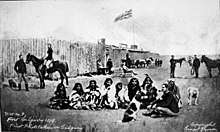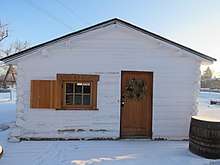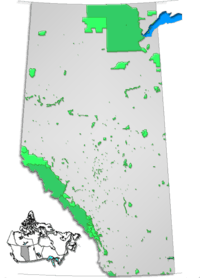Fort Calgary
Fort Calgary was established in 1875 as Fort Brisebois[1] by the North-West Mounted Police at the confluence of the Bow and Elbow rivers, on traditional Niitsitapi (Blackfoot) territory in what is now called Calgary. The fort was built to control the illegal American whiskey trade, to make way for the coming Canadian Pacific Railway, and to create 'good relations' with the Indigenous peoples of the territory. The site was purchased by the City of Calgary in 1974 and reopened in 1978 as a historic site and museum.
| Fort Calgary | |
|---|---|
| Native name Mohkinstsis; Wîchîspa; Guts'ists'i | |
 North-West Mounted Police with Kainai Nation members at Fort Calgary, 1878. | |
| Etymology | Calgary House, a castle at Calgary Bay on the Isle of Mull, Scotland |
| Location | 750 9th Avenue SE Calgary, Alberta T2G 5E1 |
| Coordinates | 51°02′43″N 114°02′44″W |
| Area | 2.64 km2 (1.02 sq mi) |
| Founded | 1875 |
| Built | 1875 |
| Original use | North-West Mounted Police fort (used until 1914) |
| Current use | Museum, park, social centre |
| Architectural style(s) | Pine and Spruce logs |
| Governing body | Fort Calgary Preservation Society |
| Owner | City of Calgary |
| Website | Official website |
History
Early history
Fort Calgary is situated at the confluence of the Bow and Elbow River. It is located on the traditional territory of the Niitsitapi (Blackfoot Confederacy; Siksika, Kainai, Piikani), the îyârhe Nakoda (Chiniki, Bearspaw, Wesley), the Tsuut'ina people and Métis Nation, Region 3.[2] For thousands of years the confluence has been a significant gathering place; It is where many world views have collided, forever changing the people and the place. In the Niitsitapi (Blackfoot) language the word for the confluence is mohkinstsis; the îyârhe Nakoda (Stoney) word is wîchîspa; the Tsuut'ina (Sarcee) word is guts’ists’i; the Nehiyaw (Cree) word is otoskwanik. Mayor Naheed Nenshi (A'paistootsiipsii; Iitiya) states that,
"There have always been people here. In Biblical times there were people here. For generations beyond number, people have come here to this land, drawn here by the water. They come here to hunt and fish; to trade; to live; to love; to have great victories; to taste bitter disappointment; but above all to engage in that very human act of building community".[3]
Establishment

The North West Mounted Police (NWMP) were created on May 23, 1873 by Prime Minister John A. MacDonald to control the illegal whiskey trade and to create relations with the Indigenous people of the territory. The recruited men left Dufferin, Manitoba in the summer of 1874 to begin their "March West". Commanded by Éphrem A. Brisebois, "F" Troop, a group of 150 men, travelled north from Fort Macleod to find a suitable spot on the Bow to build the fort. On arrival at the location they made a makeshift boat with a wagon box and tarpaulins to cross the Bow. Corporal George Clift King was the first member of the troop to set foot on the location, which is why he is sometimes cited as Calgary's first citizen. Construction began in August or September and the fort was completed in time to host Christmas dinner for the local residents.
The original fort was constructed out of pine and spruce logs cut upstream and floated to the site. Buildings included men's quarters, a guard room, stables and storage facilities. Shortly after the erection of the fort, two businesses set up operation in the vicinity; I. G. Baker Company and the Hudson's Bay Company.
The post was originally called "The Elbow" or "Bow Fort". Captain Brisebois attempted to name the fort after himself, but due to his unpopularity, it was renamed Fort Calgary in 1876 by Colonel James MacLeod, after Calgary House, a castle at Calgary Bay on the Isle of Mull, Scotland.
Contemporary history
With the decline in the whiskey and buffalo trade, the fort was down to four constables by 1880.[4] However, in preparation for the arrival of the railway, much of the fort was torn down in 1882 and new barracks were constructed. The arrival of the railway in 1883 and the subsequent rapid growth and expansion of Calgary destroyed the post's reason for existing. A two-storey building that could house 100 men was built in 1888, since a fire in 1884 had destroyed one of the barracks. The site continued as Calgary Barracks, although largely for police and for other civilian uses.[2]

In 1914, The Grand Trunk Pacific Railway bought the site[2] for $250,000[5] for use as a rail terminal and demolished all the fort buildings except the Deane House, and for 61 years Fort Calgary was hidden beneath a warehouse yard.
In 1969–70, an archaeological crew from the University of Calgary began searching for the Fort at the then current site of MacCosham's warehouse. The site was eventually located under a storage yard behind the MacCosham's building. The crew unearthed original wooden beams from the Fort and a multitude of historical artifacts. An art installation created by Jill Anholt titled Markings outlines the boundaries of the original fort site.[6]
In 1974, under the direction of Alderman John Ayer, the City of Calgary reclaimed the land and it was designated a provincial and National Historic Site. The present heritage interpretive site was opened on May 18, 1978. A replica of the 1888 men's barracks was completed in 2000 at the current fort site, followed by the erection of palisades.
Fort Calgary has been undergoing significant organizational and brand changes, under the direction of the Fort Calgary Preservation Society. The MakeHistory campaign began as a method to generate funds to give new life to the fort through renovations and upgrades. Phase I was to restore the Deane House and the Hunt House; Phase II created Markings surrounding the original fort site; Phase III is about to begin which will redesign the museum, offer new educational programs, and broaden the perspective to the stories that are shared. The new museum, scheduled to open in 2020, will focus on the central themes of confluence and change.[7] Stemming from the Truth and Reconciliation Commission of Canada (2015), Fort Calgary has dramatically shifted its focus to better include Indigenous perspectives, knowledges, teachings, voices, and understanding of these lands.[8]
Nearby landmarks

Located at the confluence of the Bow and Elbow River, east of Downtown Calgary, the Fort is situated near two historical landmarks, the Deane House, and the Hunt House, on the opposite side of the Elbow River.
Deane House
The Deane House was built near Fort Calgary in 1906 for the superintendent of Fort Calgary, Captain Richard Burton Deane. He wrote about the house in his 1916 memoir Mounted Police Life in Canada.[9] The house was originally constructed near 9th Ave and 6th St SE, facing east towards the barracks. Deane felt the previous superintendent's house was not good enough for his wife Martha. Although the budget for the project was $5,000, the total cost was $6,200. In 1914, the house was bought by the Grand Trunk Railway and moved to the southeast corner of the lot to act as an office and station master's house.[10] The house was then purchased by C. L. Jacques in 1929 and moved across the Elbow River, where it stands today. It was used as a boarding house for several decades and was named Jasper Lodge. It was later purchased by Alex Brotherton who renamed the building Gaspé Lodge.[11] Alex Brotherton died in the home in 1968 and the property was sold and proceeds divided among his children (Alfena Cunningham and Patrica Brotherton (Patricia Perkins), whose descendants still live in Calgary.
In 1973, the city bought the building and turned it into cooperative studio space for artists and writers and an exhibition space called the Dandelion Gallery.[12] In the summer of 1975, Joan Clark, Edna Alford and Velma Foster published the first edition of Dandelion Magazine, a publication that would become known as Alberta's leading literary magazine.[13] In 1978, the City closed the Dandelion Artists' Cooperative with plans to turn the house into a teahouse and restaurant.[12] Today, the house continues to be owned by the city. It currently features a restaurant called Deane House and has undergone significant renovations as part of the MakeHistory upgrades to Fort Calgary.[14]
Hunt House
The Hunt House is the oldest building in Calgary still located on its original site. It was built between 1876 and 1881 for Métis employees of the Hudson's Bay Company located at 8th Street and 9th Avenue SE. The last person to live in the house was William Hunt, a rail worker, who died in the mid 1970s.[15] It became an Alberta Provincial Historic Resource in 1977.[16] The Métis Cabin, thought to have been built around the same time, was moved to the Calgary Brewing and Malting Company grounds in the 1930s and recently has been moved back to its original spot.
Affiliations
The museum is affiliated with: CMA, CHIN, and Virtual Museum of Canada.
References
- Canada's Historic Places - Fort Calgary National Historic Site of Canada Retrieved July 24, 2018
- "History of Fort Calgary". Fort Calgary. Retrieved 21 October 2018.
- WDS, CoC. "Naming Reconciliation Bridge - Mayor Nenshi's speech". calgarymayor.ca. Retrieved 2018-07-22.
- Foran, Max (1982). Calgary, Canada's frontier metropolis : an illustrated history. Windsor Publications. p. 44. ISBN 0-89781-055-4.
- Foran, Max (1982). Calgary, Canada's frontier metropolis : an illustrated history. Windsor Publications. p. 62. ISBN 0-89781-055-4.
- "Make History | Fort Calgary". Fort Calgary. Retrieved 2018-07-24.
- "The Story Continues: Fort Calgary MAKE HISTORY Museum Expansion Project | Fort Calgary". Fort Calgary. Retrieved 2018-07-24.
- "The Story Continues: Fort Calgary MAKE HISTORY Museum Expansion Project | Fort Calgary". Fort Calgary. Retrieved 2018-07-25.
- Deane, Captain R. Burton. "Mounted Police Life in Canada: A Record of Thirty-one Years' Service". Archive.org. Retrieved June 27, 2019.
- "Fort Calgary | MAKE HISTORY - Deane House Rehabilitation". www.fortcalgary.com. Retrieved 2018-07-25.
- Alberta Register of Historic Places Retrieved 2018-12-06
- Sanders, Harry (2005). Historic Walks of Calgary. Calgary, Alberta: Red Deer Press. p. 174. ISBN 0-88995-297-3.
- Melnyk, George (1999). The Literary History of Alberta, Volume Two. Edmonton, Alberta: University of Alberta Press. p. 180. ISBN 0-88864-324-1.
- East Village Free Press Retrieved 22 October 2015
- "The old calgary shack at the heart of our history | CBC News". CBC. Retrieved 2018-07-24.
- "The Glenbow Museum > Archives Photographs Search Results". ww2.glenbow.org. Retrieved 2018-07-25.
